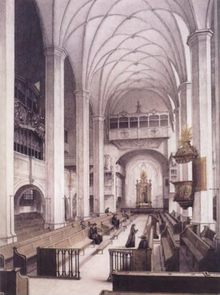Liebster Gott, wenn werd ich sterben, BWV 8
| Liebster Gott, wenn werd ich sterben? BWV 8 | |
|---|---|
| Chorale cantata by Johann Sebastian Bach | |
 Thomaskirche, Leipzig 1885 | |
| Occasion | 16th Sunday after Trinity |
| Based on | hymn by Caspar Neumann |
| Performed | 24 September 1724: Leipzig |
| Movements | 6 |
| Vocal | SATB choir and soloists |
| Instrumental |
|
Liebster Gott, wenn werd ich sterben? (Dearest God, when will I die?),[1] BWV 8, is a church cantata by Johann Sebastian Bach. He composed the chorale cantata in Leipzig for the 16th Sunday after Trinity and first performed it on 24 September 1724. It is based on the hymn by Caspar Neumann.
History and text
Bach composed the cantata in his second year as Thomaskantor in Leipzig for the 16th Sunday after Trinity. It is based on the hymn of the same name by Caspar Neumann, part of Bach's second cantata cycle, planned as a cycle of chorale cantatas.
The prescribed readings for the Sunday were from the Epistle to the Ephesians, praying for the strengthening of faith in the congregation of Ephesus (Ephesians 3:13–21), and from the Gospel of Luke, the raising from the dead of the young man from Nain (Luke 7:11–17).
Bach first performed the cantata on 24 September 1724.
Scoring and structure
The piece is scored for horn, flauto traverso, two oboes d'amore, strings (violins, violas and basso continuo), vocal soloists and choir.[2] It is in six movements, in E major unless otherwise noted:
| No. | Title | Text | Type | Vocal | Winds | Strings | Key | Time |
|---|---|---|---|---|---|---|---|---|
| 1 | Liebster Gott, wenn werd ich sterben? | Chorus | SATB | 1 flauto transverso, 2 oboe d'amores, natural horn (col soprano) | 2 violins, 1 viola | E major | 12/8 | |
| 2 | Was willst du dich, mein Geist, entsetzen | Aria | tenor | 1 oboe d'amores | C-sharp minor | 3/4 | ||
| 3 | Zwar fühlt mein schwaches Herz | Recitative | alto | 2 violins, 1 viola | ||||
| 4 | Doch weichet, ihr tollen, vergeblichen Sorgen! | Aria | bass | 1 flauto transverso | 2 violins, 1 viola | A major | ||
| 5 | Behalte nur, o Welt, das Meine! | Recitative | soprano | 1 flauto transverso | 2 violins, 1 viola | |||
| 6 | Herrscher über Tod und Leben | Chorale | SATB | 1 flauto transverso (col soprano), 1 oboe d'amore (col soprano), 1 oboe d'amore (coll'alto) 1 natural horn (col soprano) | 1 violin (col soprano), 1 violin (coll'alto), 1 viola (col tenore) | E major |
Music
The opening chorus is a gapped chorale setting of the tune. The alto, tenor, and bass voices sing free counterpoint, while the sopranos sing the chorale unadorned in long notes. Philipp Spitta described the sound of this movement as a "church-yard full of flowers in the springtime". The setting has a "popular" sound because of the use of 12/8 time and the unique nature of the accompaniment figures: plucked arpeggios, bell tones, and "sinuous" or "lazy" patterns.[3]
The tenor aria is characterized by continued bell tones and string pizzicato in the accompaniment, and a duet with oboe for the vocal line. The following alto recitative "brings forth a bit of the terror of death", in contrast with the "amazingly jolly" aria in "jig tempo" that follows. The soprano recitative leads into a "marching" chorale setting to end the cantata.[3]
Other version
An alternative version of the cantata in D major is also extant, believed to be from 1746–47. Several minor changes to the instrumentation were also implemented; for example, in the first movement the two oboe parts are given to concertante violins, and in the bass aria, the oboe d'amore is used colla parte with the flute. Both variants have been recorded: the aria by Ton Koopman with Klaus Mertens as the bass soloist and the Amsterdam Baroque Orchestra, and the chorus by Koopman's pupil Masaaki Suzuki and the Bach Collegium Japan in addition to the full cantata in E major.[4]
Recordings
The selection is taken from the listing on the Bach Cantatas Website.[4]
- Amsterdam Baroque Orchestra & Choir, Ton Koopman. Challenge Classics 2000, CC72212.
- Bach Collegium Japan, Masaaki Suzuki. BIS 2004, CD1351.
- Collegium Vocale Gent, Philippe Herreweghe. Harmonia Mundi France 1998, HMC901659.
- Leonhardt-Consort, Choir of King's College, Cambridge, Gustav Leonhardt. Teldec 1971.
- Monteverdi Choir, English Baroque Soloists, John Eliot Gardiner. Soli Deo Gloria 2000, 104.
- Münchener Bach-Chor, Münchener Bach-Orchester, Karl Richter. Bach Cantatas Vol. 4 – Sundays after Trinity. Archiv Produktion 1959.
- The Bach Ensemble, Joshua Rifkin. Decca L'Oiseau-Lyre 1988, 455 706–2.
References
- ^ Dellal, Pamela. "BWV 8 – "Liebster Gott, wenn werd ich sterben?"". Emmanuel Music. Retrieved 22 August 2016.
- ^ "BWV 8 Liebster Gott, wenn werd ich sterben?". University of Alberta. Retrieved 3 November 2013.
- ^ a b Smith, Craig. "BWV 8". Emmanuel Music. Retrieved 28 May 2013.
- ^ a b Oron, Aryeh. "Cantata BWV 8 Liebster Gott, wenn werd ich sterben?". Bach Cantatas Website. Retrieved 22 August 2016.
Sources
- Liebster Gott, wenn werd ich sterben, BWV 8: Scores at the International Music Score Library Project
- Liebster Gott, wann werd ich sterben (1st version) BWV 8; BC A 137a / Chorale cantata (16th Sunday after Trinity) Bach Digital
- Liebster Gott, wann werd ich sterben (2nd version) BWV 8; BC A 137b / Chorale cantata (16th Sunday after Trinity) Bach Digital
- BWV 8 Liebster Gott, wenn werd ich sterben? English translation, University of Vermont
- Meinrad Walter: Sterben, Betrübnis, Dank / Drei dramatische Themen in J. S. Bachs musikalischer Sprache des Glaubens bachkantaten.ch
- Luke Dahn: BWV 8.6 bach-chorales.com
